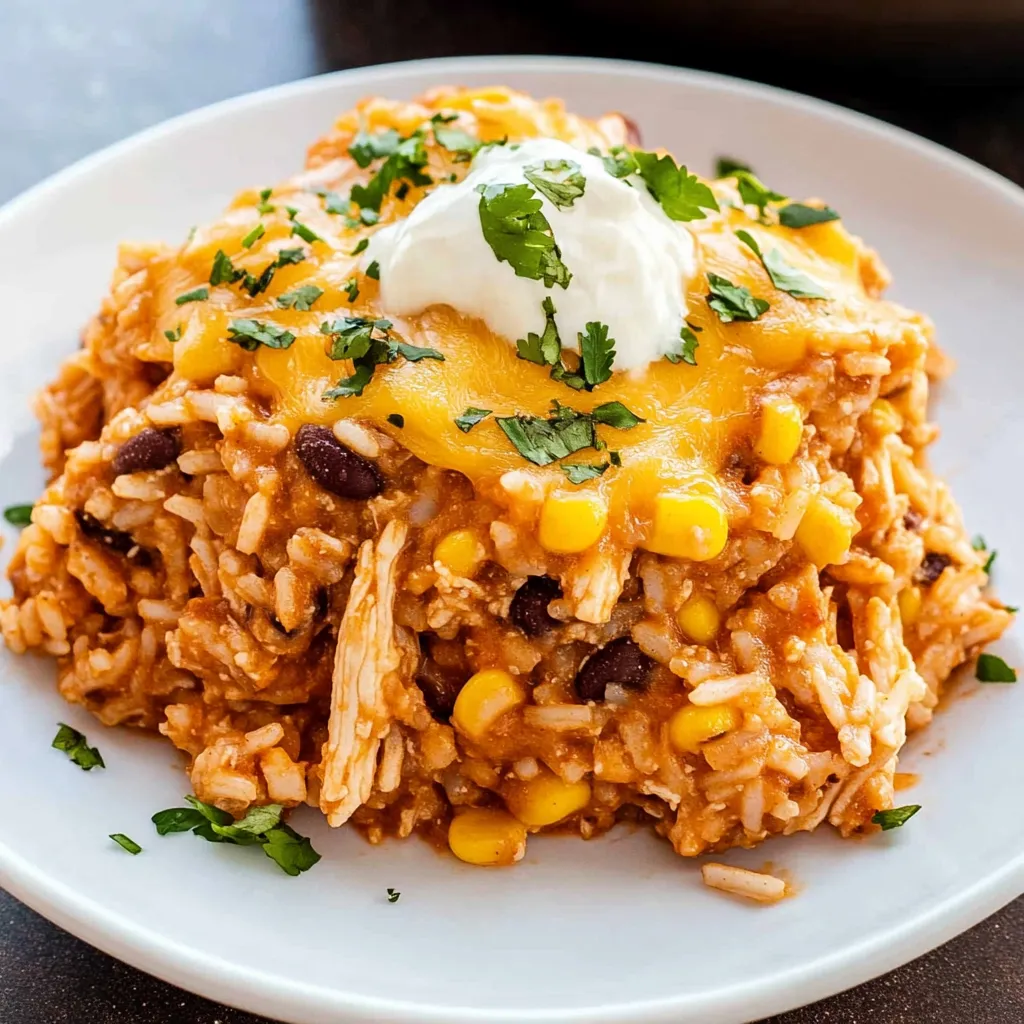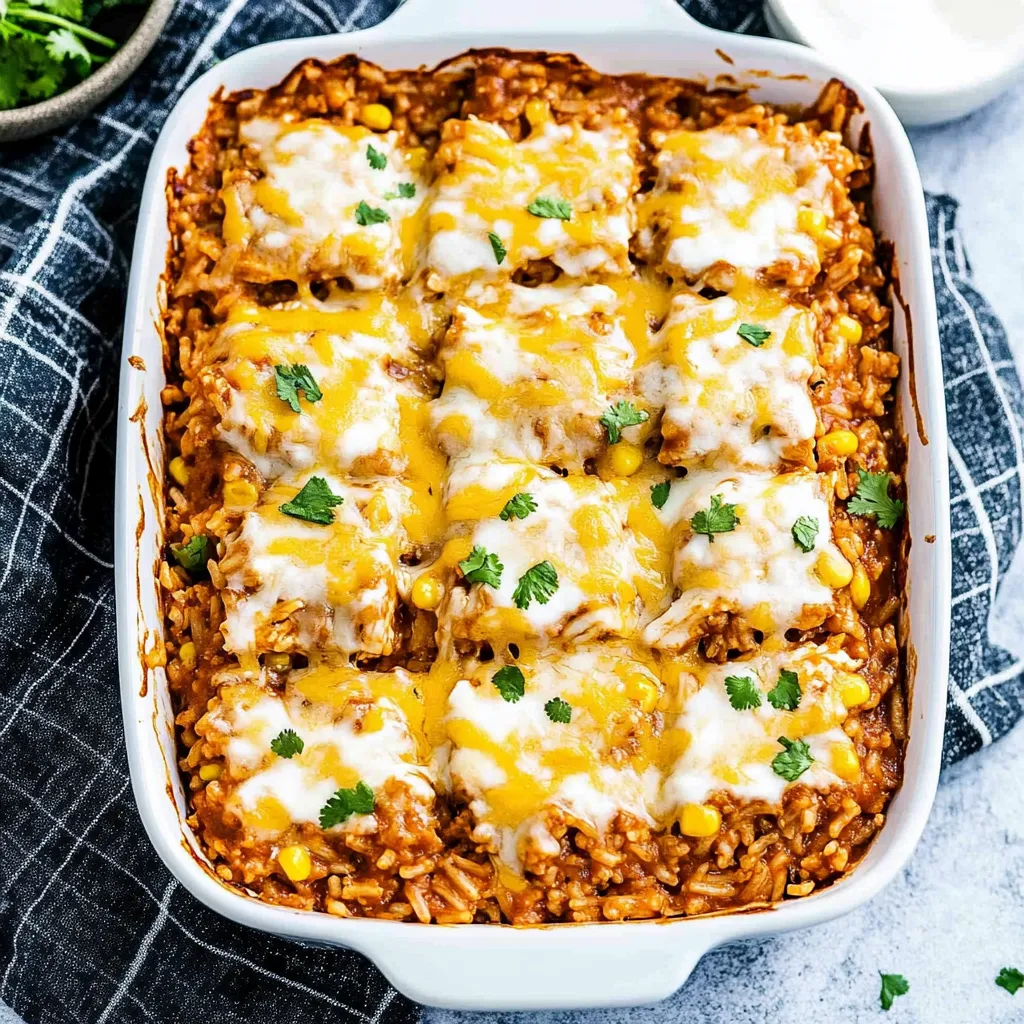 Pin it
Pin it
This comforting chicken enchilada rice casserole delivers all the bold, cheesy flavors of traditional enchiladas in an easy one-dish format that feeds a crowd without all the rolling and assembly work. The combination of tender shredded chicken, creamy refried beans, and perfectly cooked rice gets brought together with rich enchilada sauce and a generous layer of melted cheese that creates pure comfort food magic. Unlike complicated enchilada recipes that require individual rolling and precise placement, this casserole approach lets you simply mix everything together and let the oven do the work while developing those deep, satisfying flavors.
I discovered this recipe when I was craving enchiladas but didn't have time for all the rolling and individual assembly that traditional enchiladas require. The first time I made it, my family was amazed that something so simple could taste exactly like their favorite restaurant enchiladas, and now this has become our go-to whenever we want Mexican comfort food without the fuss.
Essential Ingredients and Selection Tips
- Cooked chicken: Rotisserie chicken saves time and adds extra flavor; if cooking your own, season the chicken well and don't overcook to prevent dryness
- White rice varieties: Basmati or jasmine rice work beautifully; avoid brown rice or wild rice as they have different cooking times and textures
- Quality enchilada sauce: Homemade provides the best flavor, but good store-bought red enchilada sauce works perfectly for convenience
- Mixed cheeses: Combine white cheddar and Monterey Jack for the best melting and flavor; Mexican cheese blends also work wonderfully
- Refried beans: Choose varieties without added lard if preferred; these add creaminess and protein while stretching the dish economically
- Corn: Frozen corn kernels work better than canned as they hold their shape and don't add excess liquid to the casserole
- Fresh cilantro: Select bunches with bright green leaves for the freshest flavor garnish
The secret to perfect texture is properly cooking and fluffing the rice so it doesn't become mushy, then combining everything while the rice is still slightly warm to help flavors meld together.
Detailed Step-by-Step Instructions
- Step 1: Prepare the rice properly:
- Rinse 2 cups of white rice in a fine mesh strainer under cold running water until the water runs clear - this removes excess starch that can make rice gummy. In a medium saucepan, bring 4 cups of water to a rolling boil, then add the rinsed rice and return to a boil.
- Step 2: Cook rice to perfection:
- Once boiling, reduce heat to low, cover tightly with a lid, and simmer for exactly 18 minutes without lifting the lid. Remove from heat and let stand covered for 5 minutes, then fluff gently with a fork to separate the grains and create the ideal texture.
- Step 3: Prepare the chicken:
- If using rotisserie chicken, remove all skin and shred the meat into bite-sized pieces using two forks. If cooking fresh chicken, season breasts well and cook until internal temperature reaches 165°F, then let cool slightly before shredding. You'll need about 3 cups of shredded chicken total.
- Step 4: Preheat and prep:
- Set your oven to 350°F and lightly grease a 9x13-inch baking dish with cooking spray or butter. This prevents sticking and makes serving much easier later.
- Step 5: Create the mixture base:
- In a large mixing bowl, combine the shredded chicken with the enchilada sauce, making sure every piece gets coated. Add the refried beans and mix gently until evenly distributed - the beans will help bind everything together and add creaminess.
- Step 6: Add vegetables and cheese:
- Stir in the corn kernels and half of your cheese mixture, reserving the remaining cheese for topping. The corn adds sweetness and texture contrast, while the mixed-in cheese will melt and help bind all the components.
- Step 7: Incorporate the rice:
- Add the fluffy, cooked rice to the chicken mixture and fold everything together gently but thoroughly. Season with salt and pepper to taste, remembering that the enchilada sauce and cheese already contribute saltiness.
- Step 8: Assemble for baking:
- Transfer the entire mixture to your prepared baking dish, spreading it evenly with a spatula. Sprinkle the remaining cheese evenly over the top - this will create that beautiful golden, bubbly surface that makes casseroles so appealing.
- Step 9: Bake to perfection:
- Place in the preheated oven and bake for 20-30 minutes until the cheese is melted, bubbly, and lightly golden around the edges. The casserole should be heated through completely and the top should look appetizing and golden.
- Step 10: Finish and serve:
- Remove from oven and let rest for 5 minutes to allow the mixture to set slightly for easier serving. Garnish with fresh chopped cilantro for color and brightness, then serve while hot.
 Pin it
Pin it
The most important technique is not overmixing the rice once it's added to prevent breaking the grains, and ensuring the casserole is heated through completely for food safety and best texture.
This casserole has become such a family favorite because it proves that you don't need complicated techniques to create deeply satisfying, restaurant-quality flavors at home. My neighbor's teenage son, who claims to be picky about "mixed-up" foods, always asks if we're making "that amazing rice thing" whenever he sees me cooking, which I consider the ultimate endorsement.
Understanding Casserole Science and Heat Distribution
Successful casseroles depend on understanding how heat moves through layered ingredients and how different components behave when baked together. The rice acts as a starch base that absorbs flavors while providing structure, while the cheese layer on top creates an insulating effect that allows the interior to heat evenly without drying out. The refried beans help bind everything together and prevent the casserole from becoming dry or separating during baking. Proper oven temperature ensures the cheese melts and browns appealingly while heating the entire dish through without overcooking any single component.
Rice Preparation and Texture Management
The success of this casserole hinges on properly prepared rice that maintains its individual grain structure rather than becoming mushy or sticky. Rinsing removes surface starch that can cause clumping, while the absorption method with precise timing and resting creates fluffy, separate grains. Using the rice while slightly warm helps it absorb some of the enchilada sauce flavors while maintaining its texture. The rice continues to absorb liquid during baking, which is why the sauce-to-rice ratio is important for achieving the perfect final consistency.
Flavor Layering and Sauce Integration
The enchilada sauce serves multiple purposes beyond just flavoring - it provides moisture that prevents the casserole from drying out while creating the signature taste that makes this dish recognizable. Coating the chicken thoroughly with sauce ensures flavor penetration, while mixing some cheese into the base layer creates pockets of melted richness throughout rather than just on top. The corn adds subtle sweetness that balances the chile heat, while the beans contribute earthiness and creaminess that rounds out the flavor profile.
Cheese Selection and Melting Techniques
Using a combination of cheeses creates both superior flavor and better melting characteristics than single varieties. White cheddar provides sharp, tangy notes while Monterey Jack offers excellent melting properties and mild flavor that doesn't overpower. Reserving cheese for both mixing and topping ensures richness throughout while creating an appealing browned surface. Freshly grated cheese melts more smoothly than pre-shredded varieties, which contain anti-caking agents that can affect texture and browning.
Make-Ahead and Storage Strategies
This casserole is exceptionally well-suited for advance preparation, making it ideal for busy schedules or entertaining. The dish can be completely assembled up to 24 hours ahead and refrigerated, though it may need slightly longer baking time if starting from cold. The flavors actually improve during the resting period as components meld together. For freezing, proper wrapping prevents freezer burn while allowing the casserole to maintain quality for up to three months. Thawing overnight in the refrigerator ensures even reheating and prevents texture issues.
This chicken enchilada rice casserole has taught me that some of the most beloved family recipes are the ones that take familiar flavors and present them in a way that's both comforting and convenient. Every time I make it, I'm reminded that good home cooking often comes down to understanding how to combine simple ingredients in ways that create something greater than the sum of their parts, proving that delicious doesn't have to mean difficult.
Frequently Asked Questions
- → Can I use rotisserie chicken for this recipe?
- Yes! Rotisserie chicken works great. Just shred the breast and thigh meat and use about 1½ pounds total.
- → What type of rice should I use?
- Use white rice only - long grain, medium grain, or short grain all work. Don't use brown rice or wild rice.
- → How long does this casserole keep in the fridge?
- Store leftovers in the fridge for 3-4 days in an airtight container. Reheat in the microwave or oven.
- → Can I freeze this casserole?
- Yes, it freezes well for up to 3 months. Thaw overnight in the fridge before reheating in the oven.
- → What can I add to make it spicier?
- Add cumin, coriander, garlic powder, or diced jalapeños. You can also use spicy enchilada sauce instead of mild.
- → Can I add vegetables to this recipe?
- Sure! Bell peppers, mushrooms, or diced onions work well. Add them with the other ingredients before baking.
